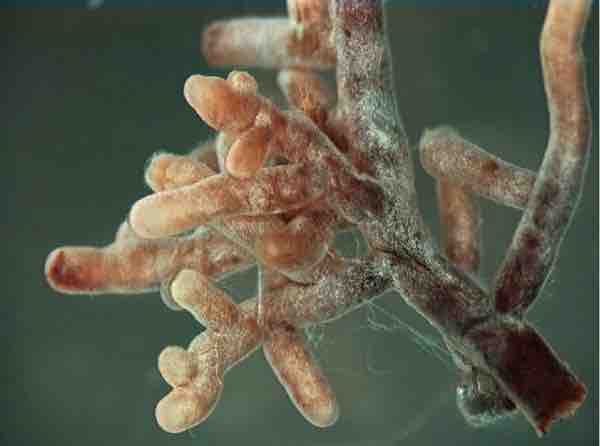A mycorrhiza is a symbiotic (generally mutualistic, but occasionally weakly pathogenic) association between a fungus and the roots of a vascular plant.
In a mycorrhizal association, the fungus colonizes the host plant's roots, either intracellularly as in arbuscular mycorrhizal fungi (AMF or AM) or extracellularly as in ectomycorrhizal fungi. They are an important component of soil life and soil chemistry. Mycorrhizas form a mutualistic relationship with the roots of most plant species. While only a small proportion of all species has been examined, 95% of those plant families are predominantly mycorrhizal.
They are named after their presence in the plant's rhizosphere (root system). This mutualistic association provides the fungus with relatively constant and direct access to carbohydrates, such as glucose and sucrose. The carbohydrates are translocated from their source (usually leaves) to root tissue and on to the plant's fungal partners. In return, the plant gains the benefits of the mycelium's higher absorptive capacity for water and mineral nutrients due to the comparatively large surface area of mycelium: root ratio, thus improving the plant's mineral absorption capabilities. Plant roots alone may be incapable of taking up phosphate ions that are demineralized in soils with a basic pH. The mycelium of the mycorrhizal fungus can, however, access these phosphorus sources and make them available to the plants they colonize.
Suillus tomentosus, a fungus, produces specialized structures, known as tuberculate ectomycorrhizae, with its plant host lodgepole pine (Pinus contorta var. latifolia). These structures have in turn been shown to host nitrogen fixing bacteria which contribute a significant amount of nitrogen and allow the pines to colonize nutrient-poor sites.
Plants grown in sterile soils and growth media often perform poorly without the addition of spores or hyphae of mycorrhizal fungi to colonize the plant roots and aid in the uptake of soil mineral nutrients.
Fungi have been found to have a protective role for plants rooted in soils with high metal concentrations, such as acidic and contaminated soils. Pine trees inoculated with Pisolithus tinctorius planted in several contaminated sites displayed high tolerance to the prevailing contaminant, survivorship, and growth.
Mycorrhizas are present in 92% of plant families studied (80% of species) , with arbuscular mycorrhizas being the ancestral and predominant form and the most prevalent symbiotic association found in the plant kingdom. The structure of arbuscular mycorrhizas has been highly conserved since their first appearance in the fossil record.

Mycorrhizal root tips (amanita)
This mycorrhiza includes a fungus in the genus Amanita.